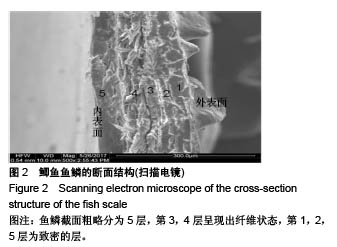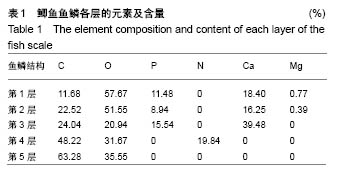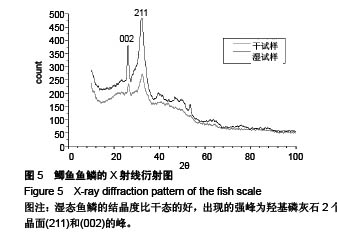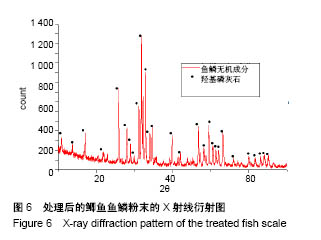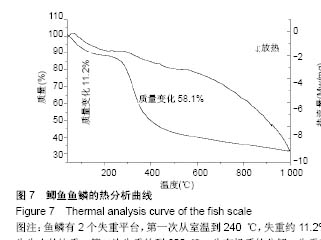| [1] Kardong KV.Vertebrates : comparative anatomy, function, evolution. McGraw-Hill Higher Education, 2015.[2] Zarrin J,Rui LA,Barraca JP.Manycore simulation for peta-scale system design: Motivation, tools, challenges and prospects.Simulat Model Pract Theory.2017;72(8):168-201.[3] 聂小宝,潘洪民,程丽林,等.鲫鱼鱼鳞胶原蛋白提取工艺的研究[J].山东农业科学,2012,44(1):109-111.[4] Liu S,Zhao P,Zhang J,et al.Physicochemical and functional properties of silver carp (Hypophthalmichthys molitrix) myofibrillar protein glycated with konjac oligo-glucomannan.Food Hydrocoll.2017;67(6):216-223.[5] 陈日春,郑宝东.鲢鱼鱼鳞胶原蛋白抗氧化活性肽提纯及结构鉴定研究进展[J].食品安全质量检测学报,2017,8(4):1339-1345.[6] 杜嵇华,梁旭方,程佳齐,等.草鱼脂肪酸去饱和酶和延长酶基因cDNA全序列的克隆与分析[J].暨南大学学报(自然科学与医学版),2011,32(5):513-520.[7] Marino Cugno Garrano A,La Rosa G,Zhang D,et al.On the mechanical behavior of scales from Cyprinus carpio.J Mech Behav Biomed Mater. 2012;7:17-29.[8] Lin YS,Wei CT,Olevsky EA,et al.Mechanical properties and the laminate structure of Arapaima gigas scales.J Mech Behav Biomed Mater. 2011; 4(7):1145-1156. [9] Meyers MA,Lin YS,Olevsky EA,et al.Battle in the Amazon: Arapaima versus Piranha.Adv Eng Mater. 2012;14(5):B279-B288. [10] Vernerey FJ,Barthelat F.On the mechanics of fishscale structures.Int J Solids Struct.2010;47 (17):2268-2275. [11] Zimmermann EA,Gludovatz B,Schaible E,et al.Mechanical adaptability of the Bouligand-type structure in natural dermal armour.Nat Commun. 2013;4:2634. [12] 刘鹏,汪俊文,朱德举.草鱼鳞片的多级结构及力学性能[J].复合材料报, 2016, 33(3):657-665.[13] Yang W,Sherman VR,Gludovatz B,et al.Protective role of Arapaima gigas, fish scales:Structure and mechanical behavior.Acta Biomaterialia. 2014; 10(8):3599-3614.[14] Fang Z,Wang Y,Feng Q,et al.Hierarchical structure and cytocompatibility of fish scales from Carassius auratus.Mater Sci Eng C Mater Biol Appl. 2014;43:145-152.[15] Nicolas G,Gaill F,Zylberberg L.In situ localization of twofibrillar collagens in two compact connective tissues by immunoelectronmicroscopy after cryotechnical processing.Histochem Cytochem. 1997;45:119-128.[16] Oslon OP,Watabe N.Studies on formation and resorption offish scales. Cell Tissue Res.1980;211:303-316.[17] Gullekson C,Lucas L,Hewitt K,et al.Surface-Sensitive Raman Spectroscopy of Collagen I Fibrils. Biophys J.2011;100(7):1837-45.[18] 黄建生,孙耀,唐启升.黄渤海常见鱼类鳞片的形态特征[J].中国水产科学, 2015,22(3):528-544.[19] 王玉坤.鲫鱼鱼鳞的分级结构及其生物学性能[D].中国地质大学, 2013.[20] Yang W,Chen IH,Gludovat ZB,et al.Natural flexible dermal armor.Adv Mater.2013;25(1):31-48.[21] Zhu D,Ortega CF,Motamedi R,et al.Structureand mechanical performance of a“modern”fish scale.Adv Eng Mater.2012;14(4):185-194.[22] dePaula SM,Huila MF,Araki K,et al.Confocal Raman and electronic microscopy studies on the topotactic conversion of calcium carbonate from Pomacea lineate shells into hydroxyapatite bioceramic materials in phosphate media.Micron.2010;41(8):983-989. [23] Zhu D,Szewciw L,Vernerey F,et al.Puncture resistance of the scaled skin from striped bass: collective mechanisms and inspiration for new flexible armor designs.J Mech Behav Biomed Mater.2013;24:30-40. [24] Chintapalli RK,Mirkhalaf M,Dastjerdi AK,et al.Fabrication, testing and modeling of a new flexible armor inspired from natural fish scales and osteoderms.Bioinspir Biomim.2014;9(3):036005. [25] Browning A,Ortiz C,Boyce MC.Mechanics of composite elasmoid fish scale assemblies and their bioinspired analogues.J Mech Behav Biomed Mater.2013;19:75-86. [26] 赵丹阳,郭纯方,田倩倩,等.仿生鲨鱼皮减阻微沟槽滚压复制技术基础研究[C]//先进成型与材料加工技术国际研讨会,2014.[27] 钱风超.仿生鱼鳞形凹坑表面减阻性能的数值研究[D].大连理工大学,2013.[28] Murcia S,Lavoie E,Linley T,et al.The natural armors of fish: A comparison of the lamination pattern and structure of scales.J Mech Behav Biomed Mater.2017;73:17-27. [29] Arola D,Murcia S,Stossel M,et al.The Limiting Layer of Fish Scales: Structure and Properties.Acta Biomaterialia.2017;67:319-330.[30] 高聚琼,陈东辉,孙霁宇,等.鲤鱼鱼鳞断面的微观结构及纳米力学性能[J].农机化研究,2006,28(11):147-150.[31] 高聚琼.鲤鱼鳞片表面特性和泥鳅体表粘液润滑性能[D].吉林大学,2006.[32] Ikoma T,Kobayashi H,Tanaka J,et al.Microstructure, mechanical, and biomimetic properties of fish scales from Pagrus major.J Struct Biol. 2003;142(3):327-333.[33] Gil-Duran S,Arola D,Ossa EA.Effect of chemical composition and microstructure on the mechanical behavior of fish scales from Megalops Atlanticus.J Mech Behav Biomed Mater.2016;56(22):2729-2747. |
.jpg)

